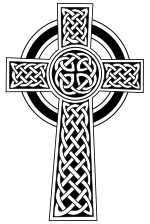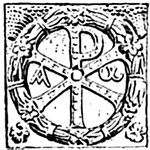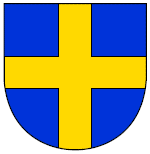Cross

A cross is a geometrical figure consisting of two lines or bars intersecting each other at a 90° angle, dividing one or two of the lines in half. The lines usually run vertically and horizontally; if they run diagonally, the design is technically termed a saltire.
The cross is one of the most ancient human symbols, and is used by many religions, most notably Christianity. It is frequently a representation of the division of the world into four elements (or cardinal points), or alternately as the union of the concepts of divinity, the vertical line, and the world, the horizontal line (Koch, 1955).
History
It is not known when the first cross image was made; after circles, crosses are one of the first symbols drawn by children of all cultures. There are many cross-shaped incisions in European cult caves, dating back to the earliest stages of human cultural development in the stoneage. Like other symbols from this period, their use continued in the Celtic cultures in Europe. For example, celtic coins minted many centuries before the Christian era may have an entire side showing this type of cross, sometimes with the five cardinal points marked by concave depressions in the same style as in stoneage carvings. Other coins may be showing the cross held by a rider on a horse and springing forth a fern leaf, sometimes identified as a Tree of Life symbol. These early sun crosses or celtic crosses have nothing to do with later Christian ones.
Other early images of crosses were found in the Central Asian steppes, and some were found in Altay. The cross in the old Altaic religion called Tengriism symbolizes the god Tengri and the three-world cosmology; it wasn't an elongated "dagger" cross, instead resembling a plus sign (+).
The first Christian books from Armenia and Syria contained evidence that the cross originated with horsemen from the east, possibly referring to the first Turkic people[citation needed]. In old Armenian temples, some stylistic Turkic influences are found in cross symbols[citation needed]. Named animal, the symbol was found in the plans of temples, with the pillars from above looking like an additional cross.
As markings
Written crosses are used for many different purposes, particularly in mathematics.
- The Roman numeral for ten is X.
- In the Latin alphabet, the letter X and the minuscule form of t are crosses.
- The Chinese character for ten is 十; (see Chinese numerals).
- The dagger or obelus (†)
- The addition (or plus) sign (+) and the multiplication (or times) sign (×).
- If n≥1 is an integer, the numbers coprime to n, taken modulo n, form a group with multiplication as operation; it is written as (Z/nZ)× or Zn*.
A cross is often used as a check mark because it can be clearer, easier to create with an ordinary pen or pencil, and less obscuring of the text or image that is already present than a large dot. It also allows marking a position more accurately than a large dot.
A large cross through a text often means that it is wrong or should be considered deleted.
As emblems and symbols
| Cross Name | Description | Picture |
|---|---|---|
| Ankh |
Also known as the Key of the Nile, the Looped Tau Cross, and the Ansated Cross. It was an Ancient Egyptian symbol of life. Sometimes given a Latin name if it appears in specifically Christian contexts, such as the crux ansata ("handled cross"). |
|
| Canterbury cross |
Used in the Anglican and Episcopal Churches. It has four arms of equal length, each widening at the outer end in a hammer shape so that their rims form a near circle. Each arm bears a triangular panel incised with a triquetra symbolizing the Trinity. In the center of the cross is a small square. The Saxon original dates from c. 850 A.D. and was excavated in 1867 in Canterbury, England. A stone replica can be found in all twelve Anglican cathedrals worldwide. | |
| Christian cross |
Also known as the Latin cross or crux ordinaria. It is the most common symbol of Christianity, intended to represent the redeeming martyrdom of Jesus when he was crucified on the True Cross in the New Testament. |
|
| Coptic Cross |
A small circle from which emanate four arms of equal length, with angled T shapes in the corner, cross-pieces outward, representing the nails used in Jesus' crucifixion. |
|
| Greek cross |
Also known as the crux immissa quadrata. Has all arms of equal length. |
|
| Byzantine Orthodox Cross |
Used in the Eastern Orthodox Church. The top line is said to represent the headboard, and the bottom, slanted line represents the footrest, wrenched loose by Jesus' writhing in intense agony. The letters IC XC found at the end of the main arm of most Eastern Orthodox Crosses are a Christogram, representing the name of Jesus Christ. |
|
| High cross |
Free-standing Celtic crosses commonly found in Ireland and to a lesser extent in Great Britain, very common in churches and graveyards. |
|
| Labarum |
Constantine I's Labarum is also known as a Chrismon, or monogram of the name Jesus Christ. Several other forms of Chrismons exist. |
|
| Lorraine Cross |
Used in heraldry. It is similar to a patriarchal cross, but usually has one bar near the bottom and one near the top, rather than having both near the top. |
|
| Nordic Cross | ||
| Papal Cross |
The three cross-bars represent the Roman Catholic Pope's triple role as Bishop of Rome, Patriarch of the West, and successor of St. Peter, Chief of the Apostles. |
|
| Patriarchal cross |
Similar to a traditional Christian cross, but with an additional, smaller crossbar above the main one ment to represent all the Orthodox Christian Archbishops and Patriarchs. In the Russian Orthodox Church, this cross is sometimes seen with an additional, slanted bar near the foot of the cross. This cross is also known as a Lorraine Cross, and as a Caravaca Cross. |
|
| Red Cross |
Used as a symbol for medical care in most of the world, the Red Crescent being used in Islamic countries and the Magen David Adom in Israel. |
|
| Cross of Sacrifice |
A Latin cross with a superimposed sword, blade down. It is a symbol used by the Commonwealth War Graves Commission at the site of many war memorials. |
|
| Saint Andrew's Cross |
Used in Scotland's national flag, it is also called the Saltire, the Boundary Cross (because it was used by the Romans as a barrier) and the crux decussata. Saint Andrew is believed to have suffered a martyr's death on such a cross, hence its name. The cross does not have to be at this particular angle to qualify as a saltire; the symbol X can also be considered a St. Andrew's Cross. |
|
| St George's Cross |
Used in England's national flag. |
|
| Saint Peter's Cross |
An upside-down Latin cross, based on a tradition that holds that Saint Peter was martyred by being crucified upside-down. Today it is often associated with anti-Christian or Satanic groups. |
|
| Skull and crossbones |
Not a cross as such, but a saltire made of bones, with an overlaid skull. Traditionally used by Freemasons, and was the battle flag of the Knights Templar fleet, later pirates. It was actually relatively rarely used by pirates, each ship having its own design, often involving an hourglass. |

|
| Sun cross |
Also known as the Sunwheel, solar cross or Odin's cross, because Odin's symbol in Norse mythology was a cross in a circle. |
|
| Tau Cross |
Also known as Saint Anthony's Cross, the Egyptian Cross and the crux commissa. It is shaped like the letter T. Francis of Assisi used it as his signature. |
|
| Thieves' Cross |
Also known as the Furka Cross. The fork, shaped like the letter Y. |
|
| Mariner's Cross |
The Mariner's Cross is a stylized cross in the shape of an anchor. The Mariner's Cross is also referred to as St. Clement's Cross in reference to the way he was martyred. |
|
| Bent cross |
Also known as the swastika, it is an equilateral cross with its arms bent at right angles in either left-facing or right-facing direction. The swastika is a holy symbol in Hinduism, Jainism and Buddhism. In the West, it is more widely known as a symbol of Nazism, however it is also used in Heathenry. It is traditionally oriented so that a main line is horizontal, though it is occasionally rotated at forty-five degrees, and the Hindu version is often decorated with a dot in each quadrant. The Nazi swastika always faces right, which has led to the decreased use of the right-facing version of this cross as religious symbols outside of India. They are now mostly left-facing. |
|
| Dobbs Icon |
The Dobbs Icon is a stylized cross with three bars and a pipe, placed in a pattern that matches the eyes, nose, mouth, and pipe of J. R. "Bob" Dobbs's image. This symbol of the Church of the SubGenius resembles a parody of the patriarchal cross. Image copyright © The SubGenius Foundation, Inc. |
In heraldry
These crosses are ones used exclusively or primarily in heraldry, and do not necessarily have any special meanings commonly associated with them. Crosses that are used in heraldry but also commonly in other contexts are not listed here.
| Cross name | Description | Picture |
|---|---|---|
| The cross as heraldic "ordinary" |
A simple heraldic cross (the default if there are no additional specifying words) has arms of roughly equal length, artistically proportioned to the particular shape of the shield, which extend to the edges of the shield. Illustrated is the blazon "Azure, a cross Or" (i.e. a gold cross on a blue shield). A cross which does not extend to the edges of the shield is humetty, in heraldic terminology. |
|
| Cross bottony |
A cross with the ends of the arms bottony (or botonny), i.e. shaped like an architectural trefoil. It occurs counterchanged on the flag of Maryland. |
 |
| Cross cercelée |
|
|
| Cross crosslet |
A cross with the ends of each arm crossed. |
 |
| Crusaders' cross |
Also known as the Jerusalem cross. This cross was the symbol of the Crusader Kingdom of Jerusalem, which existed for almost two hundred years after the First Crusade. The four smaller crosses are said to symbolize either the four books of the Gospel or the four directions in which the Word of Christ spread from Jerusalem. Alternately, all five crosses can symbolize the five wounds of Christ during the Passion. This symbol is also used in the flag of Georgia. |
|
| Cross flory |
A cross with the ends of the arms flory (or fleury), having a shape like a fleur-de-lys. |
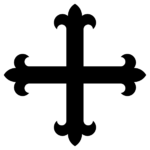 |
| Cross fourchee |
One form of the heraldic cross fourchee (fourchée, fourchy) or cross fourche (meaning "forked"). |
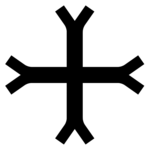 |
| Jerusalem cross |
A variant of the Crusaders' cross with cross potent. |
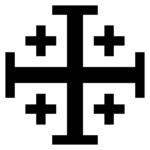 |
| Maltese cross |
With arms which narrow towards the center, and are indented at the ends. The "eight-pointed cross" (with no curved lines). |
 |
| Cross moline |
In a cross moline, the ends of the arms are split and curved back. |
 |
| Cross patonce |
A cross patonce is more or less intermediate between a cross pattée and a cross flory (or fleury). |
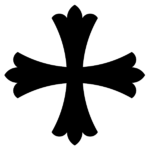 |
| Cross pattée |
A cross pattee (pattée, patty) has arms narrowing towards the centre, but with non-indented ends. See the cross pattée article for discussion of variant forms. See also Iron Cross. |
 |
| Cross pommee |
A cross pommee (pommée, pommy) has a circular knob at the end of each arm. |
 |
| Cross potent |
This cross has a crossbar at the end of each of its arms. "Potent" is an old word for a crutch, and is used in heraldic terminology to describe a T shape. |
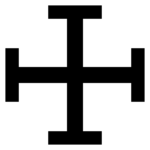 |
| Quadrate |
A cross with a square at the intersection point. |
 |
| Cross triple parted and fretted |
In heraldry, a "cross triple parted and fretted" (or "treble parted and fretted") is interlaced. Here, a version which is "Or on an Azure field" (gold on blue) is shown. |
 |
| Cross voided |
A "cross voided throughout", also known as the Gammadia, can be seen as a Greek cross with its centre lines removed, or as composed of four angles (L shapes) separated by a thin space. So the name "gammadia" refers to its being made up of four shapes similar to a capital Greek letter gamma; the word gammadion can also refer to a swastika. |
|
| Cross of St James |
The Cross of St. James,, or a Cross Flory Fitch, is formed by a Cross Flory, where the lower part is fashioned as a sword blade (fitched)—making this a cross of a warrior. |
There are numerous other variations on the cross in heraldry. See heraldry for background information.
See also: Anchored Cross, Cross barby (barbée), Fylfot
The semi-classic book A Glossary of Terms Used in Heraldry by James Parker (1894) is online, and contains much information about variants of crosses used in heraldry.
In flags
Several flags have crosses, including all the nations of Scandinavia, whose crosses are known as Scandinavian crosses, and many nations in the Southern Hemisphere, which incorporate the Southern Cross. The Flag of Switzerland since the 17th century has displayed an equilateral cross in a square (the only square flag of a sovereign state apart from the Flag of the Vatican City); the Red Cross emblem was based on the Swiss flag.
Other noteworthy crosses
The Crux, or Southern Cross, is a cross-shaped a constellation in the Southern Hemisphere.
The tallest cross, at 152.4 meters high, is part of Francisco Franco's monumental "Valley of the Fallen", the Monumento Nacional de Santa Cruz del Valle de los Caidos in Spain.
See also
- Iron Cross
- Knights Templar
- Knights Hospitaller
- Christianity
- Freemasonry
- Diabolical signature
- Demons and symbols
- Double cross
- Crossbuck
- Cross and Crown
- Cathars
References
- Koch, Rudolf (1955). The Book of Signs. Dover, NY. ISBN 0486201627.




